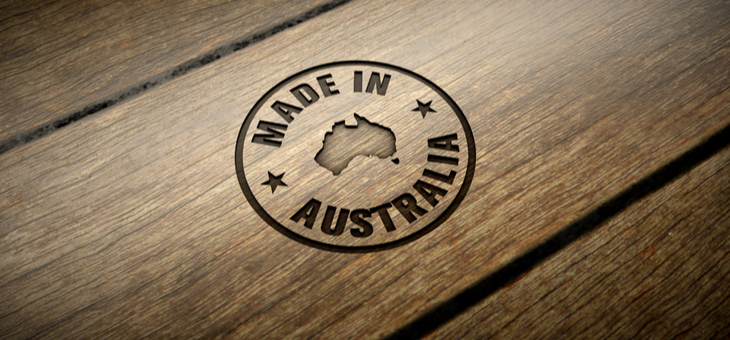Australia is the least self-sufficient economy in the developed world.
A new report from The Australia Institute’s Centre for Future Work ranks Australia last among OECD countries for manufacturing self-sufficiency – the volume of goods manufactured versus the volume of manufactured goods used.
Australia produces two-thirds as much manufactured output as it consumes, while most other OECD countries produce more manufactured goods than they consume.
The COVID-19 pandemic has highlighted the vulnerability of product supply chains and Australia’s reliance on imports, amplifying calls for a boost to local manufacturing.
“Australia has one of the most underdeveloped manufacturing sectors of any industrial country in the world,” report author and director of the centre Jim Stanford told ABC News.
“Most other industrial countries have manufacturing sectors that are successful and large enough to, in aggregate, meet their own domestic needs for manufactured products.
“In Australia’s case, however, we’re using more manufactured goods all the time but we’re producing a smaller and smaller share of those.
“I think there is a mistaken assumption that if you’re a rich, high-wage, industrial country, you just can’t do manufacturing. After all, it’s much cheaper to do things in China or Thailand or some other low-wage country.
“We found that traditional assumption is absolutely false.”
In the late 1980s, manufacturing was the biggest employer in Australia, with 16.5 per cent of the workforce.
Now fewer than one million people work in the sector, accounting for 6.4 per cent of jobs.
Manufacturing’s contribution to GDP peaked in the late 1950s and into the `60s when it was just shy of 30 per cent. Now it has shrunk to about 5.5 per cent.
Total employment in the sector has dropped by 9.6 per cent since 2010, the report shows.
Dr Stanford estimates that increasing Australia’s manufacturing self-sufficiency to 100 per cent could add another $180 billion a year in new manufacturing output, boost GDP by $50 billion a year and add more than 650,000 direct and indirect jobs.
“I think it’s a pragmatic and ambitious goal to try to rebuild manufacturing in Australia back to a level that’s comparable to our own need for manufacture,” Dr Stanford said.
He wants Australia to stop relying on the export of minerals such as lithium, which could be made into value-added products.
“About two-thirds of all world trade consists of manufactured products, so if you don’t have a strong domestic manufacturing base, you’re shutting yourself out of most world commerce,” he said.
Vonda Fenwick, chief executive of the South East Melbourne Manufacturers Alliance (SEMMA), is one of the voices urging more support for Australian manufacturing.
“If you look at any economically successful country in the world, you’re looking at a country that’s got a healthy, robust, industrialised sector; you’ve got a country that’s manufacturing.
“It simply makes sense for us to be really sticking to those policies, making sure that we’re buying locally, making sure that we are mandating local content requirements to ensure that we’re providing work for manufacturing.”
Australian Manufacturing Workers’ Union national secretary Paul Bastian told the AFR he welcomed the report, and boosting manufacturing jobs was necessary to lower unemployment after the pandemic.
“The idea that we are moving to some sort of ‘post-industrial’ economy where manufacturing is irrelevant is nonsense. Almost every job requires manufactured goods,” he said.
“Manufacturing is a growing industry globally, and demand for manufactured goods is increasing here in Australia. Growing Australia’s manufacturing sector so we make as much as we use will create hundreds of thousands of high-wages, high-skill secure jobs.”
Former AFR deputy editor Greg Earl has outlined his vision for boosting manufacturing. He says domestic manufacturing can help fill the gaps in the supply chain created by COVID-19 restrictions and the federal government can create policies to “help build the nation’s economic resilience”.
He says a competitive manufacturing industry requires a “stable energy supply and a bigger focus on science and technology in Australia’s education system” and supports the decision to review all foreign investment, calling it “one of the most wide-ranging increases in foreign investment regulation in the world”.
“It underlines how greater scrutiny of foreign investment could play a big role in domestic economic resilience.”
He says building stockpiles of “designated strategic equipment” such as personal protective equipment should be part of an economic security plan; the government has already boosted the strategic oil reserve.
The government has taken direct action during the pandemic to increase production of surgical masks and pay for special cargo flights to support exports of perishable food products to Asia. But a long-term solution is required to ensure ‘economic sovereignty’ in Australia.
Mr Earl is concerned that Australia’s trade dependence on China “is greater than with any country since Britain in the middle of last century”, and some companies with ‘just-in-time’ supply chains are vulnerable.
“Rebuilding a competitive manufacturing industry in Australia won’t succeed without some basic foundational changes. These range from a greater focus on science and technology in the education system to a more stable energy system, possibly through domestic gas reservation.
“Then there are even broader issues, including industrial relations to improve worker flexibility and new approaches to tax such as cash-flow taxation to encourage investment.”
Do you think Australia needs to become more economically self-reliant?
If you enjoy our content, don’t keep it to yourself. Share our free eNews with your friends and encourage them to sign up.
Related articles:
https://www.yourlifechoices.com.au/finance/news/budget-numbers-will-get-worse
https://www.yourlifechoices.com.au/finance/legal-and-general/how-to-search-for-lost-money
https://www.yourlifechoices.com.au/health/covid19/the-truth-about-face-masks

